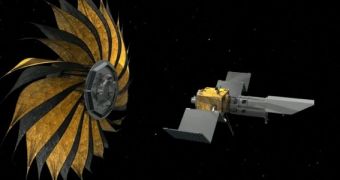A team of engineers and scientists from the NASA Jet Propulsion Laboratory (JPL) in Pasadena, California, and the Princeton University are currently working on developing a new type of spacecraft for the American space agency, which would enable it to collect direct images of extrasolar planets for the first time ever. Currently, NASA spacecraft can only see alien worlds indirectly.
The new project calls for the development of a flower-shaped starshade, a system through which light released from a star targeted by the spacecraft is prevented from reaching its detectors. Since the detectors are then no longer overwhelmed by bright photons, the exoplanets orbiting that particular star will become more clearly visible, allowing the probe to image them directly.
The vehicle researchers are currently proposing would feature two main parts, as illustrated by this animation. The first would be the starshade itself, which in this case looks like a very large and very complex flower. This section of the spacecraft would separate from the rest and unfold in space to dimensions several times larger than when it launched.
The other section of the probe would be a space telescope that would then turn around and use the protection provided by the starshade to look at exoplanets located relatively far away from Earth. This astronomical method for direct exoplanetary imaging is called starlight suppression. The team behind this study explains that the starshade is always positioned between the telescope and the target star.
By removing starlight from the equation, the telescope's detectors will become far more likely to detect any potential light bouncing off the exoplanetary targets themselves. Imaging these alien worlds directly is touted as the best way to figure out whether or not they can support the development of life. Atmospheric studies could also become much easier, investigators say.
The effort to assemble the starshade is being led by JPL lead engineer Dr. Stuart Shaklan and Princeton professor and researcher Jeremy Kasdin, who is the principal investigator on the project. The team decided to use a flower-shaped petal arrangement for the starlight suppressor because this design is extremely effective.
“The shape of the petals, when seen from far away, creates a softer edge that causes less bending of light waves. Less light bending means that the starshade shadow is very dark, so the telescope can take images of the planets without being overwhelmed by starlight,” Shaklan explains.
“We can use a pre-existing space telescope to take the pictures. The starshade has thrusters that will allow it to move around in order to block the light from different stars,” the JPL expert goes on to say. Shaklan notes that two of the most important issues still to be solved are learning how to position the starshade precisely in space and how to accurately maintain its orientation.
“Our current task is figuring out how to unfurl the starshade in space so that all the petals end up in the right place, with millimeter accuracy,” Kasdin explains. The Princeton team, he adds, will soon begin constructing a smaller, test version of the starshade at the university, in order to assess its performances directly.
NASA experts are convinced that a working starshade is possible within just a few years and argue that such a system would have tremendous advantages. “A starshade mission would allow us to directly image Earth-size, rocky exoplanets, which is something we can’t do from the ground. We’ll be able to show people a picture of a dot and explain that that’s another Earth,” Kasdin explains.

 14 DAY TRIAL //
14 DAY TRIAL //